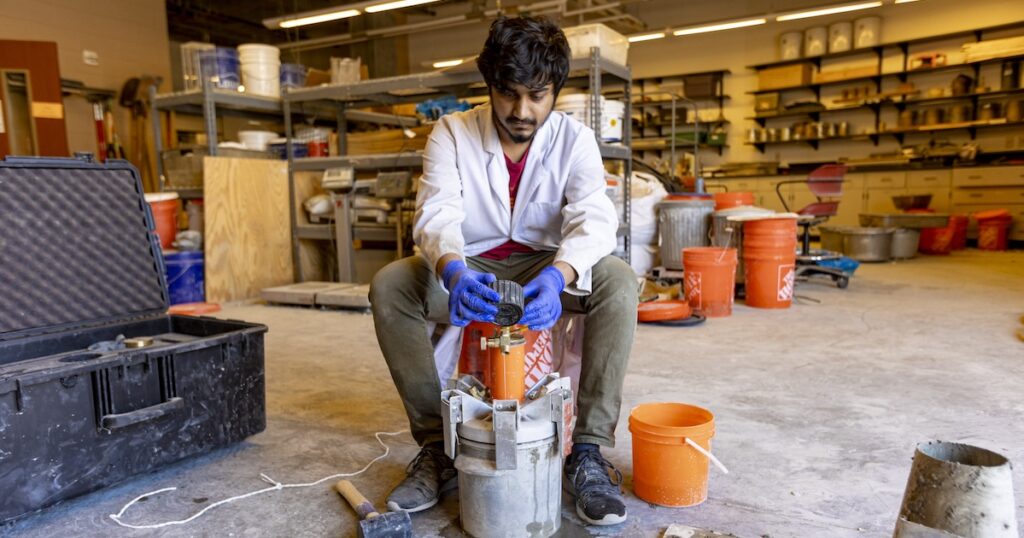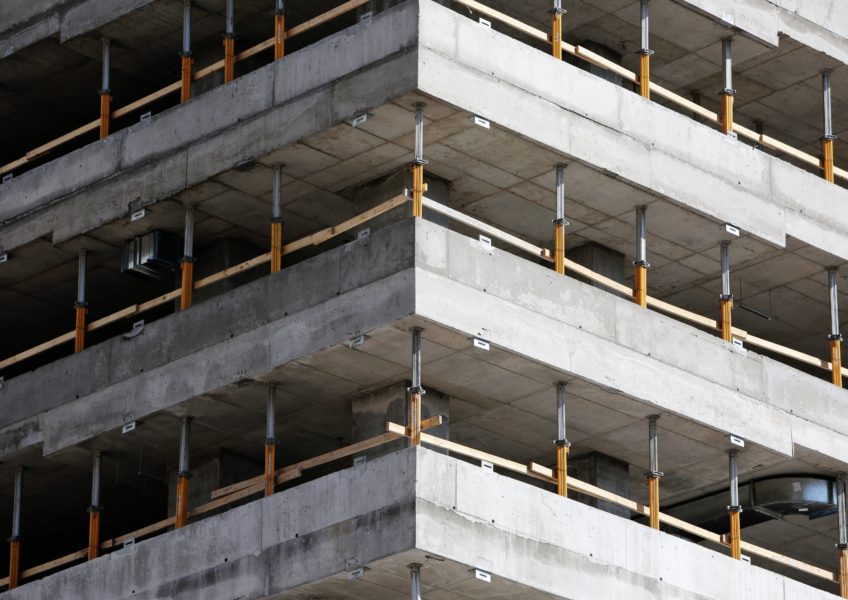The Crucial Role of Concrete Foundation in Structural Integrity and Longevity
When it pertains to developing a property, the foundation is more vital than you may believe. Concrete foundations provide unrivaled toughness and longevity, guaranteeing your framework can hold up against numerous ecological obstacles. Without a strong base, you risk potential concerns like changing or cracking, which can compromise safety and security and value. Comprehending the nuances of concrete foundations could be the trick to protecting your investment for several years ahead. So, what should you take into consideration following?
Recognizing the Relevance of Concrete Foundations
Concrete structures are important to the overall stability of any framework, as they offer the vital support required to stand up to different loads and ecological conditions. When you think of constructing a home or a business area, the foundation is the very first thing you need to think about. It serves as an obstacle versus moisture, safeguarding your residential property from water damage. A well-placed concrete structure likewise prevents settling and moving, which can lead to fractures in wall surfaces and floorings. You'll wish to guarantee that the structure is appropriately made and enhanced, as this affects the long life of your building. Furthermore, a solid foundation can boost energy performance by lowering air leaks. Bear in mind, overlooking the relevance of a concrete foundation can cause pricey repair work down the line. Investing in a high quality structure upfront is essential for the stability and resilience of your framework.
Advantages of Concrete Foundations for Structural Integrity
While numerous variables add to a building's structural stability, concrete structures supply unmatched sturdiness and toughness. You'll value that concrete can stand up to severe climate condition, resisting both moisture and temperature level variations. This strength means your structure is less most likely to experience fracturing or shifting gradually, which can endanger its safety.Additionally, concrete's integral weight provides a solid base, avoiding activity throughout all-natural events like earthquakes or floods. When you pick a concrete structure, you're likewise selecting low maintenance; unlike timber, it won't rot or attract bugs, conserving you money and time in repairs.Moreover, concrete's fire resistance uses added safety, ensuring your structure can endure heats without significant damage. Overall, purchasing a concrete structure indicates you're focusing on the long-lasting security and honesty of your structure, making it a wise option for any type of building task.
Usual Kinds Of Concrete Foundations
When it involves developing structures, comprehending the common kinds of concrete structures can assist you make informed selections for your job. The most widespread kinds consist of slab-on-grade, crawl area, and full basement foundations.A slab-on-grade structure is a basic, cost-efficient option, where a thick concrete slab is put straight on the ground. This type functions well in warm climates, as it decreases warm loss.Crawl space structures boost the home slightly over ground, allowing for air flow and accessibility to pipes and electrical systems. This style can assist avoid wetness issues.Full basement structures provide additional living or storage room while offering excellent architectural assistance. They require even more excavation and are normally used in cooler climates to stop frost heave.
Aspects to Think About When Creating a Concrete Structure

Ideal Practices for Setting Up Concrete Foundations
When you're mounting a concrete foundation, correct website preparation is important to ensure stability (West Coast General Engineering industrial concrete Rancho Cucamonga). You'll also require to comprehend reinforcement methods to boost toughness and sturdiness. Do not overlook the treating procedure, as it plays a basic duty in achieving a solid foundation.
Site Preparation Significance
It may seem uncomplicated, appropriate site prep work is crucial for guaranteeing a solid and long lasting concrete foundation. Begin by getting rid of the location of any kind of particles, plant life, or organic product that can endanger the structure's stability. Next, assess the dirt type and compaction; you could require to excavate or include materials to develop a steady base. Level the ground to assure even weight circulation and prevent settling concerns in the future. Mounting appropriate water drainage systems is likewise important to protect against water build-up, which can weaken the structure over time. Lastly, mark out the foundation's measurements precisely to guide the putting process. By following these steps, you'll establish the stage for a successful concrete foundation that stands the examination of time.
Support Methods Described
When the site is properly prepared, the following step in assuring a sturdy concrete structure involves implementing efficient support strategies. You must start by using steel rebar, which offers tensile stamina and aids protect against breaking. Lay the rebar in a grid pattern, ensuring it's elevated using spacers to keep proper insurance coverage. Furthermore, think about using wire mesh for added support, especially in locations subject to hefty loads. Don't neglect to connect the rebar crossways firmly with wire. For bigger foundations, fiber reinforcement can enhance sturdiness, reducing the danger of shrinkage splits. Always follow neighborhood building codes and standards to ensure compliance. By applying these support methods, you'll greatly boost your structure's stamina and durability, laying a solid foundation for your framework.
Healing Process Essentials
To ensure your concrete structure treatments appropriately, it is essential to maintain appropriate wetness and temperature conditions immediately after putting. you can look here Begin by covering the surface area with a damp burlap or plastic bed linen to maintain moisture. This keeps the concrete moisturized, protecting against splits and ensuring stamina. You must also keep track of the temperature level; perfect curing conditions are in between 50 ° F and 90 ° F. If it's as well hot, mist the surface frequently to avoid quick dissipation. For winter, consider using insulating blankets to preserve warmth. Go for a treating duration of a minimum of 7 days, as this is essential for optimum stamina advancement. By complying with these finest practices, you'll enhance your structure's resilience and longevity, making sure structural stability for several years to come.
Maintenance of Concrete Structures for Durability
To maintain your concrete structure strong and long lasting, normal assessments are essential. You should pebble sunstone decorative concrete floor coating likewise assure reliable water drainage remedies are in area to stop water damage. If you detect any kind of splits, addressing them promptly will save you from bigger issues down the line.

Regular Evaluations and Evaluations
While routine inspections and assessments might appear like a job, they're necessary for maintaining the honesty of your concrete foundation. By consistently checking for fractures, changes, or indications of wear, you can catch possible concerns prior to they intensify into expensive repair work. Look for any water merging around the structure or unusual settling, as these can signal underlying problems. It's likewise smart to keep an eye on any type of modifications in your house's framework, like doors that stick or windows that do not open efficiently. Maintaining a record of your evaluations helps track modifications with time, enabling for proactive maintenance. Inevitably, these evaluations assure your foundation continues to be secure, supporting the longevity and safety and security of your whole framework. Don't ignore this critical aspect of homeownership!
Efficient Drain Solutions
Routine assessments can disclose issues like drain problems that might endanger your concrete structure's security. To protect against water accumulation, assure your rain gutters and downspouts direct water away from the structure. Installing French drains pipes can successfully redirect surface area and groundwater, lowering stress on your structure walls. Additionally, grading the soil around your home aids ensure that water streams away, instead of pooling near your foundation.Consider making use of sump pumps in areas vulnerable to flooding, as they proactively get rid of excess water. On a regular basis look for clogs in drainage systems and clear them without delay. You'll shield your foundation's honesty and durability by taking these proactive procedures. Keep in mind, reliable drain solutions are essential for maintaining a strong, long lasting concrete structure.
Trigger Fracture Repairs
When you see cracks in your concrete foundation, resolving them without delay is important for maintaining its longevity. Little splits can rapidly progress into larger concerns, jeopardizing the structural stability of your home. Routinely evaluate your foundation for indicators of damages, such as horizontal or vertical fractures. If you spot any kind of, do not wait-- fix them quickly. You can utilize epoxy shots or concrete patching compounds, which work for securing splits. Constantly comply with the manufacturer's directions and take into consideration getting in touch with a professional for considerable damage. Remember, timely repairs not just boost your foundation's resilience yet additionally conserve you cash over time by preventing extra considerable repair services down the line. Keep positive, and your foundation will stay strong and protected.
Addressing Typical Problems With Concrete Structures
Concrete structures can deal with different problems in time, making it critical to recognize and address them promptly. One of the most usual troubles is breaking, which can take place as a result of temperature fluctuations or resolving dirt. If you discover splits, it's vital to analyze their dimension and depth; tiny splits can often be secured, while larger ones might need professional evaluation.Water breach is one more major worry. Excess wetness can cause mold and mildew development and structural deterioration. Assurance correct drainage around your foundation to minimize this risk. Furthermore, seek signs of moving or bowing wall surfaces, as this can show underlying issues with your foundation's stability.Regular assessments are basic to capture these problems early. If you find any kind of concerning indications, do not be reluctant to get in touch with a structure expert. By staying proactive, you can preserve the stability and longevity of your concrete foundation, guaranteeing your home remains safe and protected.
Often Asked Questions
Just How Does Dirt Kind Affect Concrete Foundation Efficiency?
Dirt kind greatly affects concrete foundation efficiency. If you've got expansive clay, for instance, it can trigger shifting and fracturing. Sandy soil may bring about working out. Recognizing your dirt helps ensure a steady foundation.
Can Concrete Foundations Be Repaired if Harmed?
Yes, you can fix damaged concrete you could try this out foundations. Depending upon the degree of the damages, strategies like epoxy injection or piece jacking can restore security. It's best to seek advice from a specialist for reliable services.
What Is the Normal Life-span of a Concrete Structure?
A concrete foundation usually lasts 30 to 100 years, depending on factors like dirt conditions, climate, and upkeep. You'll desire to watch on it to guarantee it continues to be healthy throughout its lifespan.
Exist Option Materials to Concrete for Foundations?
Yes, there are choices to concrete for structures, like steel, timber, and even recycled products. Each choice has unique advantages and disadvantages, so you need to consider your task's details demands when picking the appropriate material.
How Does Environment Impact Concrete Structure Toughness?
Climate substantially influences concrete foundation longevity (West Coast General Engineering Concrete). Severe temperature levels, wetness, and freeze-thaw cycles can damage the material, causing splits and structural problems. You need to think about neighborhood environment conditions when preparing your structure to guarantee long-lasting performance